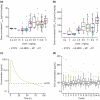Imetelstat, a novel, first-in-class telomerase inhibitor: Mechanism of action, clinical, and translational science
- PMID: 39555853
- PMCID: PMC11571238
- DOI: 10.1111/cts.70076
Imetelstat, a novel, first-in-class telomerase inhibitor: Mechanism of action, clinical, and translational science
Abstract
Most cancers and neoplastic progenitor cells have elevated telomerase activity and preservation of telomeres that promote cellular immortality, making telomerase a rational target for the treatment of cancer. Imetelstat is a first-in-class, 13-mer oligonucleotide that binds with high affinity to the template region of the RNA component of human telomerase and acts as a competitive inhibitor of human telomerase enzymatic activity. Pharmacokinetics, pharmacodynamics, exposure-response analyses, efficacy, and safety of imetelstat have been evaluated in vitro, in vivo, and clinically in solid tumor and hematologic malignancies, including lower-risk myelodysplastic syndromes (LR-MDS) and myeloproliferative neoplasms. Imetelstat was approved in the United States in June 2024 for the treatment of adult patients with LR-MDS with transfusion-dependent anemia requiring four or more red blood cell units over 8 weeks who have not responded to or have lost response to or are ineligible for erythropoiesis-stimulating agents, with a recommended dosing regimen of 7.1 mg/kg administered via 2-h intravenous infusion every 4 weeks. In the pivotal trial, significantly more patients treated with imetelstat versus placebo achieved ≥8-week and ≥24-week red blood cell-transfusion independence, and imetelstat was associated with a manageable safety profile characterized primarily by short-lived and manageable neutropenia and thrombocytopenia. This mini-review summarizes the mechanism of action, pharmacokinetic and pharmacodynamic characteristics, clinical development, and clinical efficacy and safety data of imetelstat.
© 2024 Geron Corporation. Clinical and Translational Science published by Wiley Periodicals LLC on behalf of American Society for Clinical Pharmacology and Therapeutics.
Conflict of interest statement
A.L.L., F.H., M.K.B., Y.W., L.S., T.B., and F.F. are employees of Geron Corporation, the sponsor of the work, and may hold stock or stock options. M.G.‐S., N.B., and P.N.M. are independent consultants and have been paid for the strategic and technical input into the analysis. P.N.M. may hold past or current employment and/or stock or stock options in other organizations.
Figures



References
-
- Kim NW, Piatyszek MA, Prowse KR, et al. Specific association of human telomerase activity with immortal cells and cancer. Science. 1994;266(5193):2011‐2015. - PubMed
-
- Nakamura TM, Morin GB, Chapman KB, et al. Telomerase catalytic subunit homologs from fission yeast and human. Science. 1997;277(5328):955‐959. - PubMed
-
- Lichtsteiner SP, Lebkowski JS, Vasserot AP. Telomerase. A target for anticancer therapy. Ann N Y Acad Sci. 1999;886:1‐11. - PubMed
-
- White LK, Wright WE, Shay JW. Telomerase inhibitors. Trends Biotechnol. 2001;19(3):114‐120. - PubMed
Publication types
MeSH terms
Substances
LinkOut - more resources
Full Text Sources
Research Materials
Miscellaneous

